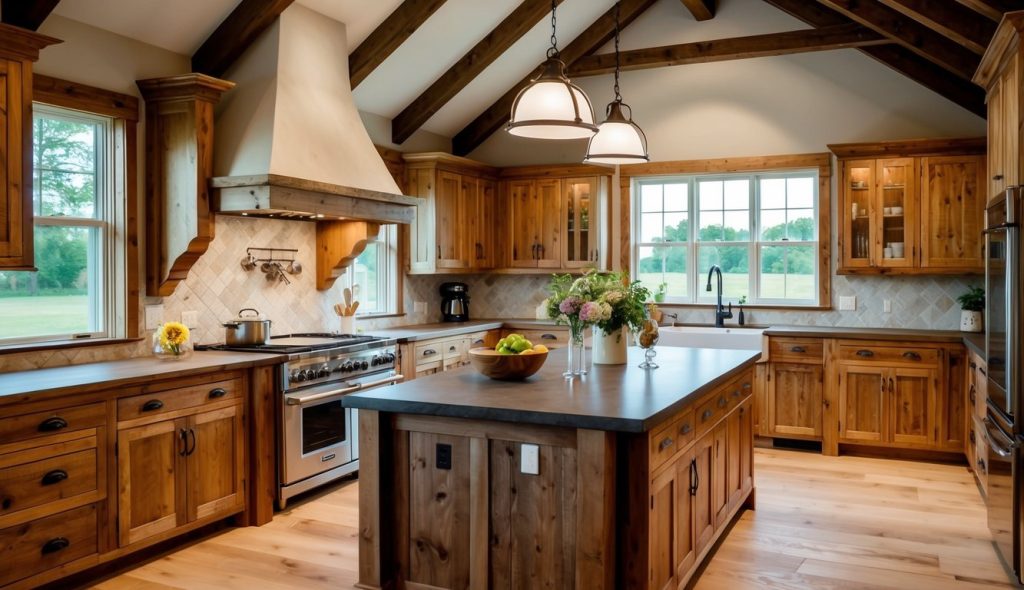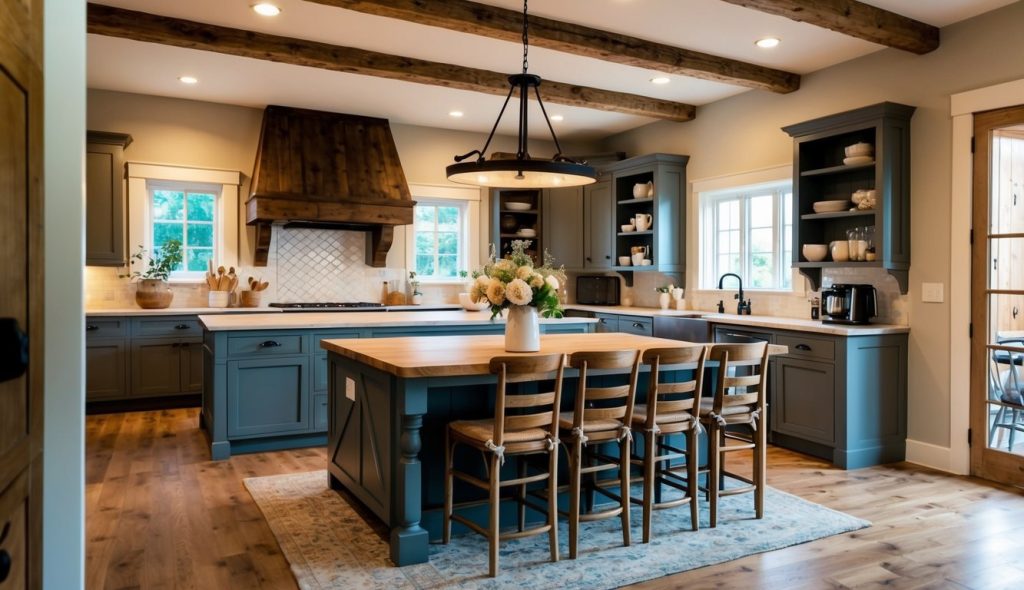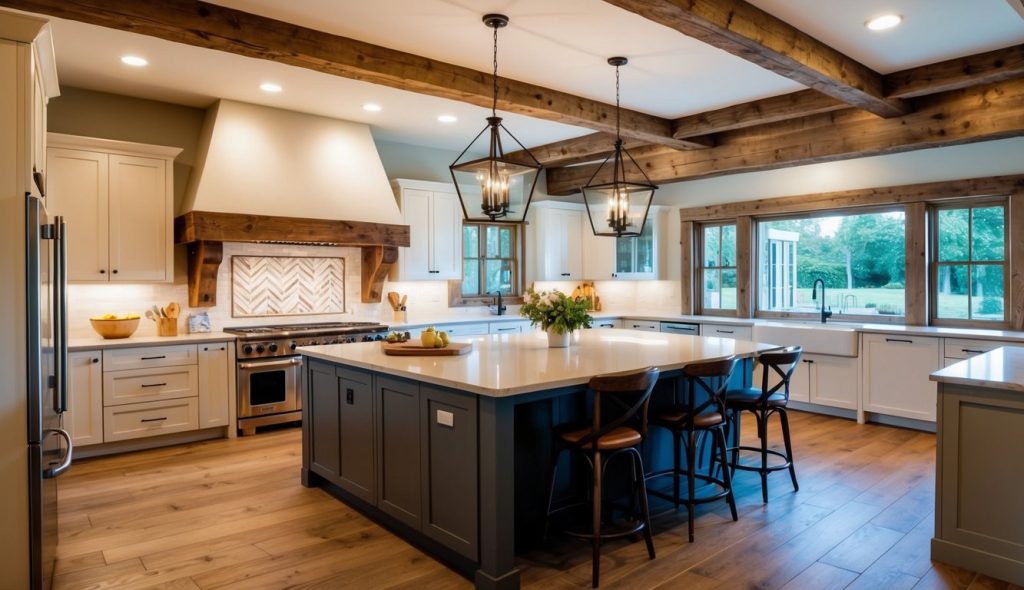Farmhouse barndominium kitchens mix rustic charm and modern usefulness. They offer a special twist by blending traditional looks with modern design. This makes them a hot pick for folks wanting a cozy and welcoming vibe at home.
With open layouts, natural materials, and thoughtful decor, these kitchens are designed to be both beautiful and practical.

This style often features elements like farmhouse sinks, exposed beams, and ample storage solutions. The integration of these design choices allows for a seamless flow between the kitchen and living areas, enhancing the overall home experience.
Homeowners can also personalize their barndominium kitchens with various accessories and finishes that showcase their unique tastes.
By focusing on the essential features and practical aspects of farmhouse barndominium kitchens, individuals can create a space that is not only visually appealing but also functional for everyday life.
Key Takeaways
- Farmhouse barndominium kitchens mix rustic design with modern convenience.
- Key elements include open layouts and natural materials.
- Personalization through decor enhances the kitchen’s charm and functionality.
The Essence of Farmhouse Barndominium Kitchens

Farmhouse barndominium kitchens blend rustic charm with modern design. This unique style highlights the beauty of natural materials while offering functionality and comfort.
Key elements include open spaces, warm colors, and a mix of traditional and contemporary features.
Defining the Farmhouse Barndominium Style
The farmhouse barndominium style is characterized by its welcoming and cozy atmosphere. Exposed wooden beams and reclaimed wood elements create a rustic feel. Many incorporate large farmhouse sinks and distressed cabinets that add warmth to the space.
Open layouts are common, allowing for smooth movement and interaction. Lighting fixtures, such as pendant lights with vintage designs, often enhance this ambiance.
Homeowners can mix modern appliances with vintage decor for a harmonious balance that reflects their personality.
Historical Roots and Modern Elegance
The origins of farmhouse kitchens date back to practical, family-oriented designs. Traditionally, these kitchens served as gathering places for cooking and socializing. Today, the barndominium style fuses this history with modern elegance.
Key features include spacious counters, versatile islands, and high-quality materials. The warm color palettes often found in farmhouse design evoke a sense of comfort. At the same time, sleek finishes and contemporary appliances ensure that these kitchens are fully functional for today’s needs.
This blend of rustic elements and modern features is what makes the farmhouse barndominium kitchen truly unique.
Design Fundamentals

Creating a farmhouse barndominium kitchen involves thoughtful planning. Important elements include floor plan configuration and selecting a color palette that enhances the space. Together, these aspects create a welcoming and functional environment.
Importance of Floor Plan Configuration
A well-thought-out floor plan is essential for a farmhouse barndominium kitchen. Open floor plans are popular as they promote a sense of space and flow. This layout allows for easy movement between the kitchen, dining, and living areas.
He or she should consider the kitchen’s function when deciding on the configuration. For example, placing appliances within reach of each other improves efficiency.
Key areas to include are cooking zones, prep areas, and storage.
Creating designated zones can help manage the kitchen’s workflow. An island can serve multiple purposes, such as providing additional seating or extra workspace. Careful planning ensures a comfortable and practical layout.
Selecting a Harmonious Color Palette
Choosing the right color palette is vital for setting the kitchen’s mood. Soft, neutral tones like whites, grays, and beiges often work well in farmhouse designs. These colors provide a clean backdrop and allow decorative elements to shine.
Accent colors can be added through cabinetry, backsplashes, or decor items. Durable materials, like reclaimed wood or metal, should match the selected palette.
Textures also play a crucial role, adding depth and warmth to the space.
Lighting must complement the chosen colors. Natural light should be maximized while using fixtures that match the overall style.
With the right palette, the kitchen will feel cohesive and inviting.
Architectural Features
In farmhouse barndominium kitchens, architectural features play a vital role in both aesthetics and functionality. The incorporation of exposed beams and the strategic use of natural light can significantly enhance the overall appeal and usability of the space.
Incorporating Exposed Beams
Exposed beams are a hallmark of rustic design. They add charm and character to kitchen spaces in a barndominium. These beams can be made from wood or even metal, depending on the style desired.
Offering a robust look, exposed beams work well with a vaulted ceiling. This combination creates a spacious feeling while maintaining the cozy ambiance typical of farmhouse aesthetics.
They can also be painted or stained to match the kitchen’s color scheme.
In addition to aesthetics, exposed beams can be functional. They serve as structural support while providing an opportunity to hang pendant lights or other fixtures, making the kitchen both attractive and practical.
Maximizing Natural Light
Natural light is essential in making a kitchen feel open and inviting. Strategic placement of windows can help achieve this goal.
Large windows or sliding glass doors are ideal for bringing in abundant daylight.
Skylights are another excellent option, especially in kitchens featuring vaulted ceilings. They allow sunlight to spill into the space, illuminating the area without sacrificing wall space.
This is particularly beneficial in open layouts where light can spread throughout.
Additionally, lighter color palettes can enhance the effect of natural light. Light cabinets and countertops reflect sunshine, making the kitchen feel even brighter and larger.
Combining these elements offers a warm, welcoming environment that elevates both design and functionality.
Kitchen Layout and Spatial Design
Creating a functional kitchen layout is crucial for maximizing usability and comfort. The design must focus on optimizing counter space and understanding the central role of the kitchen island in a farmhouse barndominium.
Optimizing Counter Space
Counter space is essential in any kitchen, especially in a farmhouse barndominium. It should be ample and easily accessible to allow for meal preparation, cooking, and serving.
Consider the following tips to optimize counter space:
- L-Shaped or U-Shaped Design: These layouts can help utilize corners while providing extensive workspace.
- Appliance Placement: Keep frequently used appliances, like mixers and blenders, close to the main prep area to enhance efficiency.
- Vertical Storage: Use wall-mounted shelves or cabinets to free up surface areas while keeping items within reach.
Incorporating these strategies can make a significant difference in the overall functioning of the kitchen.
Central Role of the Kitchen Island
The kitchen island serves as a central hub in open-concept layouts, making it a critical feature of a farmhouse barndominium. It can act as a multi-functional area for cooking, dining, and socializing.
Key benefits of including a kitchen island are:
- Additional Counter Space: It provides more surface area for food prep and cooking.
- Storage Solutions: Islands can include cabinets or shelves for storing pots, pans, and other kitchen essentials.
- Social Engagement: The island design encourages interaction among family and guests during meal preparation.
Incorporating a well-designed kitchen island can elevate both the functionality and aesthetic appeal of the kitchen space.
Material Selection and Texture
Choosing the right materials is crucial for achieving the desired aesthetic in farmhouse barndominium kitchens. Incorporating natural elements like wood and stone can enhance both the visual appeal and functionality of the space.
Wood and Stone Elements
Wood and stone are fundamental components in farmhouse barndominium kitchens. They offer warmth and charm, creating an inviting atmosphere.
- Wood: Typically, natural wood is favored for cabinets, beams, and countertops. The rich tones of oak, maple, or hickory can bring depth to the kitchen.
- Stone: Incorporating stone, whether as countertops or backsplashes, adds a rustic yet elegant touch. Options like granite or soapstone provide durability while complementing wooden features.
These materials can be combined to create stunning contrasts and harmonies, making the kitchen both beautiful and functional.
Impact of Reclaimed Wood Accents
Reclaimed wood accents have gained popularity for their unique character and environmental benefits.
- History and Texture: Each piece of reclaimed wood tells a story, bringing a sense of history to the kitchen. Its varied textures can add depth and personality.
- Sustainability: Using reclaimed wood is an eco-friendly choice. It reduces waste and lessens the demand for new lumber.
Incorporating reclaimed wood can enhance cabinetry, shelves, or even accent walls, making the kitchen feel more personalized and warm.
This approach not only emphasizes natural materials but also supports sustainable living practices.
Functional Fixtures and Appliances
In farmhouse barndominium kitchens, choosing the right fixtures and appliances is essential for both functionality and style. Key elements like the farmhouse sink and energy-efficient appliances enhance everyday cooking and clean-up tasks while maintaining the rustic charm of the design.
The Farmhouse Sink
The farmhouse sink is a signature feature in many barndominium kitchens. Its deep basin allows for easy washing of large pots and pans, making it practical for cooking and entertaining.
These sinks often come in materials like stainless steel or fireclay, offering durability and a classic look.
Farmhouse sinks also feature front-facing designs that are both aesthetic and functional.
They complement various styles, from rustic to modern. Homeowners appreciate the added space and ergonomic benefits, as these sinks reduce the strain of bending over, enhancing comfort while working in the kitchen.
Energy-Efficient Kitchen Appliances
Energy-efficient kitchen appliances are crucial in a farmhouse barndominium. They not only lower utility bills but also promote sustainability.
Many homeowners opt for stainless steel appliances because of their sleek look and long-lasting performance.
Benefits of Energy-Efficient Appliances:
- Lower energy consumption: Reduces environmental impact.
- Cost savings: Decreases electricity bills over time.
- Variety: Available in different styles, blending well with rustic design.
Investing in energy-efficient models ensures functionality without sacrificing style, making everyday tasks smoother and more eco-friendly.
Cabinetry and Storage
In farmhouse barndominium kitchens, cabinetry and storage play vital roles in both functionality and aesthetics. The right choices can enhance everyday tasks and complement the rustic charm of the space.
Customizing Kitchen Cabinets
Custom kitchen cabinets allow for a personal touch that suits individual tastes and needs. They can be designed to fit any layout, maximizing space in unique ways.
Options range from distressed wood finishes to painted colors, each adding character.
Cabinets can also include features like pull-out trays or built-in organizers. This ensures that every inch is utilized effectively, providing plenty of storage for kitchen essentials.
Choosing soft-close hardware enhances the user experience, preventing slamming doors and contributing to a peaceful kitchen environment.
Creative Storage Solutions
Exploring creative storage solutions makes a farmhouse barndominium kitchen more functional.
Open shelving creates a spacious feel and showcases decorative items. This design choice encourages keeping often-used items visible and accessible.
Incorporating a walk-in pantry can dramatically increase storage space. This dedicated area can store dry goods and appliances out of sight, keeping the kitchen looking tidy.
Additionally, using hanging racks for pots and pans not only saves space but also adds a rustic touch, making it practical and stylish. Each of these solutions helps maintain an organized cooking environment.
Accessories and Decor
When designing a farmhouse barndominium kitchen, choosing the right accessories and decor is essential. Thoughtful selections can enhance the rustic charm while adding functionality and warmth.
Key areas to focus on include light fixtures and the use of iron and vintage elements.
Choosing the Right Light Fixtures
Light fixtures are crucial in setting the atmosphere of a kitchen. In a farmhouse barndominium, fixtures should blend rustic design with modern functionality.
Popular options include:
- Pendant lights: Hang them over an island or dining table for focused illumination.
- Chandeliers: Opt for wood or wrought iron styles for a striking focal point.
- Wall sconces: These can enhance ambient lighting and accent walls.
Selecting fixtures in warm tones can complement wood finishes. Dimmer switches add versatility, allowing the homeowner to control brightness according to different times of day.
The right lighting not only illuminates the space but also adds character.
Accentuation with Iron and Vintage Elements
Incorporating iron and vintage elements can elevate the decor in a farmhouse barndominium kitchen. Iron accents bring a sturdy, rustic touch that pairs well with softer materials.
Consider these elements:
- Iron shelves: Great for displaying rustic kitchenware or botanical arrangements.
- Vintage knobs and pulls: These can be replaced on cabinets for an instant style upgrade.
- Iron stools or chairs: Adding these can create a cohesive look around a kitchen island or bar.
Vintage decor, such as old crates or kitchen tools, can serve as unique statement pieces. They tell a story and connect the kitchen to its farmhouse roots while enhancing the overall design.
Each piece should be chosen not only for aesthetics but also for how it contributes to the kitchen’s functionality.
Integration with Living Spaces
Integrating farmhouse barndominium kitchens with living spaces creates a seamless flow that enhances both functionality and aesthetic appeal. This integration allows for a cozy yet stylish environment where family and friends can gather comfortably.
Open Floor Concept
The open floor concept is a defining feature of farmhouse barndominiums. By combining the kitchen, living room, and dining areas, it fosters an inviting atmosphere.
This layout encourages interaction among occupants during cooking, dining, and relaxing.
Design elements such as large islands or breakfast bars can serve as central gathering spots. They not only provide extra prep space but also create informal dining areas.
Choosing furnishings that complement each other creates visual harmony.
Natural light plays a crucial role in this design. Large windows can brighten the space, making it feel more open and airy. This connection to nature enhances the overall farmhouse aesthetic while promoting comfort.
Outdoor Kitchen Connection
An outdoor kitchen connection extends the living space into the fresh air. This design choice is gaining popularity in modern farmhouse barndominiums.
Outdoor kitchens often include grills, sinks, and preparation areas. This setup allows for cooking and dining outside, making it perfect for entertaining.
It brings the joy of outdoor living right into the home.
To create a natural transition from the indoor kitchen to the outdoor area, consider sliding glass doors. These not only maximize views but also provide easy access.
Using similar materials for both indoor and outdoor spaces enhances the cohesive feel of the design. Think about matching countertops or cabinetry styles to further reinforce this connection.
Bonus Additions and Multifunctional Areas
In farmhouse barndominium kitchens, creating bonus spaces and multifunctional areas greatly enhances the overall utility of the home. These spaces can serve multiple purposes, making daily life easier and more enjoyable.
Incorporating a Workshop or Mudroom
Adding a workshop or mudroom can greatly improve functionality.
A workshop allows for hobbies or DIY projects, providing a dedicated space for tools and materials. Placing this near the kitchen is practical for easy access to supplies and quick clean-ups.
A mudroom serves as a buffer zone, keeping dirt and clutter from entering the main living areas.
It can include built-in shelves for storage, hooks for coats, and even a small bench. This keeps the kitchen area tidy and organized, accommodating busy households.
Designing with Bedrooms and Common Areas in Mind
When designing the kitchen, it’s essential to consider the layout of nearby bedrooms and common areas. An open floor plan contributes to a seamless flow between spaces. This means the kitchen can easily connect with the living and dining areas, encouraging family interaction.
In a barndominium, the kitchen can serve as a central hub. The proximity to bedrooms allows for late-night snacks or quick meals.
A wraparound porch complementing the kitchen adds outdoor living space, ideal for gatherings or quiet evenings. Thoughtful planning ensures that each area is functional yet harmonious.
Frequently Asked Questions
This section addresses common inquiries about farmhouse barndominium kitchens. It covers design elements, layout options, cabinet choices, space-saving ideas, color inspirations, and countertop selections.
Each question highlights specific features and practical tips that can enhance a farmhouse kitchen’s charm and functionality.
What are the key design elements for a modern farmhouse barndominium kitchen?
Key design elements for a modern farmhouse barndominium kitchen include exposed wooden beams, farmhouse sinks, and open shelving. Rustic materials like reclaimed wood and metal accents enrich the aesthetic. A neutral color palette combined with warm, inviting tones often complements the overall design.
How can one incorporate an island into a farmhouse barndominium kitchen layout?
To incorporate an island, one should consider its size and shape in relation to the kitchen space. An island can serve multiple functions, such as additional prep space or seating.
Choosing a design that harmonizes with the surrounding decor, including matching countertops and cabinet styles, ensures a cohesive look.
What types of kitchen cabinets complement a farmhouse-style barndominium?
Shaker-style cabinets are popular for a farmhouse barndominium. They highlight simplicity and craftsmanship.
Additionally, using distressed finishes or natural wood enhances the rustic charm, while white or soft pastel colors can brighten the space.
Are there any space-saving ideas suitable for small barndominium kitchens?
In small barndominium kitchens, maximize space by using vertical storage solutions like tall cabinets or open shelves. Multi-functional furniture, such as a drop-leaf table, can also save space.
Collapsible or stackable chairs provide additional seating without compromising room.
Where can I find inspiration for farmhouse barndominium kitchen color schemes?
Inspiration for color schemes can be found in home design magazines, online platforms like Pinterest, and social media.
Looking at nature also helps, as earthy tones and soft blues often resonate with farmhouse aesthetics. Visiting local showrooms can provide practical ideas based on available materials.
What should be considered when selecting countertops for a barndominium kitchen in farmhouse style?
When selecting countertops, durability and maintenance are crucial.
Popular choices include butcher block for a warm, rustic feel or quartz for a modern touch.
Color and texture should complement cabinets and overall kitchen design to create a harmonious atmosphere.